Chemical Composition, Antioxidant and Antimicrobial Activity of Some Types of Honey from Banat Region, Romania
Abstract
:1. Introduction
2. Results and Discussion
2.1. Chemical Composition
2.2. Antioxidant Activity
2.3. Antimicrobial Activity
3. Materials and Methods
3.1. Honey Samples
3.2. Determination of Humidity
3.3. Determination of Impurities
3.4. Determination of Mineral Substance Content (ash)
3.5. Determination of Acidity
3.6. Determination of pH
3.7. Determination of Reducing Sugar
3.8. Determination of Total Phenolic Content (TPC)
3.9. Determination of Flavonoid Content (FC)
3.10. Determination of Antioxidant Activity (AA) by DPPH
3.11. Antimicrobial Activity
3.11.1. Bacterial culture
3.11.2. Fungal Culture
3.12. Statistical Analysis
4. Conclusions
Supplementary Materials
Author Contributions
Funding
Institutional Review Board Statement
Informed Consent Statement
Data Availability Statement
Conflicts of Interest
Sample Availability
References
- European Parliament. Directive 2014/63/EU of the European Parliament and of the Council amending Council Directive 2001/110/EC relating to honey. Off. J. Eur. Communities 2014, 164, 1–5. [Google Scholar]
- Alqarni, A.S.; Owayss, A.A.; Mahmoud, A.A.; Hannan, M.A. Mineral content and physical properties of local and imported honeys in Saudi Arabia. J. Saudi Chem. Soc. 2014, 18, 618–625. [Google Scholar] [CrossRef] [Green Version]
- Da Silva, P.M.; Gauche, C.; Gonzaga, L.V.; Costa, A.C.O.; Fett, R. Honey: Chemical composition, stability and authenticity. Food Chem. 2016, 196, 309–323. [Google Scholar] [CrossRef] [PubMed]
- Bergamo, G.; Tischer Seraglio, S.K.; Gonzaga, L.V.; Fett, R.; Oliveira, A.C.; Costa, R. Physicochemical characteristics of bracatinga honeydew honey and blossom honey produced in the state of Santa Catarina: An approach to honey differentiation. Food Res. Int. 2019, 116, 745–754. [Google Scholar] [CrossRef]
- Mracevic, S.D.; Krstic, M.; Lolic, A.; Ražic, S. Comparative study of the chemical composition and biological potential of honeyfrom different regions of Serbia. Microchem. J. 2020, 152, 104420. [Google Scholar] [CrossRef]
- Escuredo, O.; Míguez, M.; Fernández-González, M.; Seijo, M.C. Nutritional value and antioxidant activity of honeys produced in a European Atlantic area. Food Chem. 2013, 138, 851–856. [Google Scholar] [CrossRef]
- Gül, A.; Pehlivan, T. Antioxidant activities of some monofloral honey types produced across Turkey. Saudi J. Biol. Sci. 2018, 25, 1056–1065. [Google Scholar] [CrossRef]
- Bodó, A.; Radványi, L.; K˝oszegi, T.; Csepregi, R.; Nagy, D.U.; Farkas, Á.; Kocsis, M. Melissopalynology, antioxidant activity and multielement analysis of two types of early spring honeys from Hungary. Food Biosci. 2020, 35, 100587. [Google Scholar] [CrossRef]
- Meda, A.; Lamien, C.E.; Romito, M.; Millogo, J.; Nacoulma, O.G. Determination of the total phenolic, flavonoid and proline contents in Burkina Fasan honey, as well as their radical scavenging activity. Food Chem. 2005, 91, 571–577. [Google Scholar] [CrossRef]
- Estevinho, L.; Pereira, A.P.; Moreira, L.; Luís, G.; Pereira, D.E. Antioxidant and antimicrobial effects of phenolic compounds extracts of Northeast Portugal honey. Food Chem. Toxicol. 2008, 46, 3774–3779. [Google Scholar] [CrossRef]
- Can, Z.; Yildiz, O.; Sahin, H.; Akyuz Turumtay, E.; Silici, S.; Kolayli, S. Aninvestigation of Turkish honeys: Their physico-chemical properties, antioxidant ca-pacities and phenolic profiles. Food Chem. 2015, 180, 133–141. [Google Scholar] [CrossRef]
- Dias, L.G.; Veloso, A.C.; Sousa, M.E.; Estevinho, L.; Machado, A.A.; Peres, A.M. A novel approach for honey pollen profile assessment using an electronic tongue and chemometric tools. Anal. Chim. Acta 2015, 900, 36–45. [Google Scholar] [CrossRef] [Green Version]
- Bueno-Costa, F.M.; Zambiazi, R.C.; Bohmer, B.W.; Chaves, F.C.; Da Silva, W.P.; Zanusso, J.T.; Dutra, I. Antibacterial and antioxidant activity of honeys from the state of Rio Grande do Sul, Brazil. LWT—Food Sci. Technol. 2016, 65, 333–340. [Google Scholar] [CrossRef] [Green Version]
- Kus, P.M.; Congiu, F.; Teper, D.; Sroka, Z.; Jerkovic, I.; Tuberoso, C.I.G. Antioxidant activity, color characteristics, total phenol content and general HPLC fingerprints of six Polish unifloral honey types. LWT—Food Sci. Technol. 2014, 55, 124–130. [Google Scholar] [CrossRef]
- Al-Farsi, M.; Al-Amri, A.; Al-Hadhrami, A.; Al-Belushi, S. Color, flavonoids, phenolics and antioxidants of Omani honey. Heliyon 2018, 4, e00874. [Google Scholar] [CrossRef] [Green Version]
- Shen, S.; Wang, J.; Chen, X.; Liu, T.; Zhuo, Q.; Zhang, S.Q. Evaluation of cellular antioxidant components of honeys using UPLC-MS/MS and HPLC-FLD based on the quantitative composition-activity relationship. Food Chem. 2019, 293, 169–177. [Google Scholar] [CrossRef]
- Gheldof, N.; Wang, X.H.; Engeseth, N.J. Identification and quantification of antioxidant components of honeys from various floral sources. J. Agric. Food Chem. 2002, 50, 5870–5877. [Google Scholar] [CrossRef]
- Combarros-Fuertes, P.; Estevinho, L.M.; Dias, L.G.; Castro, J.M.; Tomás-Barberán, F.A.; Tornadijo, M.E.; Fresno-Baro, J.M. Bioactive components and antioxidant and antibacterial activities of different varieties of honey: A screening prior to clinical application. J. Agric. Food Chem. 2019, 67, 688–698. [Google Scholar] [CrossRef] [Green Version]
- Martinello, M.; Mutinelli, F. Antioxidant activity in bee products: A review. Antioxidants 2021, 10, 71. [Google Scholar] [CrossRef]
- Sousa, J.M.; de Souza, E.L.; Marques, G.; Meireles, B.; de Cordeiro, Â.T.M.; Gullón, B.; Pintado, M.M.; Magnani, M. Polyphenolic profile and antioxidant and antibacterial activities of monofloral honeys produced by Meliponini in the Brazilian semiarid region. Food Res. Int. 2016, 84, 61–68. [Google Scholar] [CrossRef]
- Mandal, M.D.; Mandal, S. Honey: Its medicinal property and antibacterial activity. Asian Pac. J. Tropical Biomed. 2011, 1, 154–160. [Google Scholar] [CrossRef] [Green Version]
- Brudzynski, K. Effect of hydrogen peroxide on antibacterial activities of Canadian honeys. Can. J. Microbiol. 2006, 52, 1228–1237. [Google Scholar] [CrossRef]
- Brudzynski, K.; Abubaker, K.; St-Martin, L.; Castle, A. Re-examining the role of hydrogen peroxide in bacteriostatic and bactericidal activities of honey. Front. Microbiol. 2011, 2, 1–9. [Google Scholar] [CrossRef] [Green Version]
- Israili, Z.H. Antimicrobial properties of honey. Am. J. Ther. 2014, 21, 304–323. [Google Scholar] [CrossRef]
- Sherlock, O.; Dolan, A.; Athman, R.; Power, A.; Gethin, G.; Cowman, S.; Humphreys, H. Comparison of the antimicrobial activity of Ulmo honey from Chile and Manuka honey against methicillin-resistant Staphylococcus aureus, Escherichia coli and Pseudomonas aeruginosa. BMC Complement. Altern. Med. 2010, 10, 47. [Google Scholar] [CrossRef] [Green Version]
- El Sohaimy, S.A.; Masry, S.H.D.; Shehata, M.G. Physicochemical characteristics of honey from different origins. Ann. Agric. Sci. 2015, 60, 279–287. [Google Scholar] [CrossRef] [Green Version]
- Nolan, V.C.; Harrison, J.; Cox, J.A.G. Dissecting the antimicrobial composition of honey. Antibiotics 2019, 8, 251. [Google Scholar] [CrossRef] [Green Version]
- Kolayli, S.; Palabiyik, I.; Atik, D.S.; Keskin, M.; Bozdeveci, A.; Karaologu, S.A. Comparison of antibacterial and antifungal effects of different varieties of honey and propolis samples. Acta Aliment. 2020, 49, 515–523. [Google Scholar] [CrossRef]
- Grego, E.; Robino, P.; Tramuta, C.; Giusto, G.; Boi, M.; Colombo, R.; Serra, G.; Chiadò-Cutin, S.; Gandini, M.; Nebbia, P. Evaluation of antimicrobial activity of Italian honey for wound healing application in veterinary medicine. Band 2016, 158, 521–527. [Google Scholar] [CrossRef]
- FAOSTAT 2020. Available online: https://www.fao.org (accessed on 14 December 2021).
- Gallina, A.; Stocco, N.; Mutinelli, F. Karl Fischer Titration to determine moisture in honey: A new simplified approach. Food Control 2010, 21, 942–944. [Google Scholar] [CrossRef]
- Yücel, Y.; Sultanoglu, P. Characterisation of honeys from Hatay region by their physicochemical properties combined with chemometrics. Food Biosci. 2013, 1, 16–25. [Google Scholar] [CrossRef]
- Karabagias, I.K.; Badeka, A.; Kontakos, S.; Karabournioti, S.; Kontominas, M.G. Characterisation and classification of Greek pine honeys according to their geographical origin based on volatiles, physicochemical parameters and chemometrics. Food Chem. 2014, 146, 548–557. [Google Scholar] [CrossRef] [PubMed]
- Fechner, D.C.; Moresi, A.L.; Riuz Dıaz, J.D.; Pellerano, R.G.; Vazquez, F.A. Multivariate classification of honeys from Carrientes (Argentina) according to geographical origin based on physicochemical properties. Food Biosci. 2016, 15, 49–54. [Google Scholar] [CrossRef]
- European Parliament. EU Council Directive 2001/110 Relating to Honey (2001) Official Journal of the European Communities; European Union: Brussels, Belgium, 2001. [Google Scholar]
- Machado De-Melo, A.A.; Almeida-Muradian, L.B.; Sancho, M.T.; Pascual-Maté, A. Composition and properties of Apis mellifera honey: A review. J. Apic. Res. 2018, 57, 5–37. [Google Scholar] [CrossRef]
- Bogdanov, S.; Jurendic, T.; Sieber, R.; Gallmann, P. Honey for nutrition and health: A review. J. Am. Coll. Nutr. 2008, 27, 677–689. [Google Scholar] [CrossRef]
- Lazarević, K.B.; Andrić, F.; Trifković, J.; Tešić, Ž.; Milojković-Opsenica, D. Characterisation of Serbian unifloral honeys according to their physicochemical parameters. Food Chem. 2012, 132, 2060–2064. [Google Scholar] [CrossRef]
- Sakač, M.; Jovanov, P.; Marić, A.; Pezo, L.; Kevrešan, Ž.; Novaković, A.; Nedeljković, N. Physicochemical properties and mineral content of honey samples from Vojvodina (Republic of Serbia). Food Chem. 2019, 276, 15–21. [Google Scholar] [CrossRef]
- Pătruică, S.; Peț, I.; Simiz, E. Beekeeping in the context of climate change. In Scientific Papers; Series D; Animal Science: Bucharest, Romania, 2021; Volume LXIV, ISSN 2393-2260. [Google Scholar]
- Jakubik, A.P.; Borawska, M.H.; Socha, K. Modern Methods for Assessing the Quality of Bee Honey and Botanical Origin Identification. Foods 2020, 9, 1028. [Google Scholar] [CrossRef]
- Nalda, M.J.N.; Yagüe, J.L.B.; Calva, J.C.D.; Gómez, M.T.M. Classifying honeys from the Soria Province of Spain via multivariate analysis. Anal. Bioanal. Chem. 2005, 382, 311–319. [Google Scholar] [CrossRef]
- Madejczyk, M.; Baralkiewicz, D. Characterisation of polish rape and honeydew honey according to their mineral contents using ICP-MS and F-AAS/AES. Anal. Chim. Acta 2008, 617, 11–17. [Google Scholar] [CrossRef]
- González-Mire, M.L.; Terrab, A.; Hernanz, D.; Fernández-Recamales, M.Á.; Heredia, F.J. Multivariate Correlation between Color and Mineral Composition of Honeys and by Their Botanical Origin. J. Agric. Food Chem. 2005, 53, 2574–2580. [Google Scholar] [CrossRef]
- Tafere, D.A. Chemical composition and uses of honey: A review. J. Food Sci. Nutr. Res. 2021, 4, 194–201. [Google Scholar] [CrossRef]
- Bilandžić, N.; Đokić, M.; Sedak, M.; Kolanović, B.S.; Varenina, I.; Končurat, A.; Rudan, N. Determination of trace elements in Croatian floral honey originating from different regions. Food Chem. 2011, 128, 1160–1164. [Google Scholar] [CrossRef]
- Louppis, A.P.; Karabagias, I.K.; Kontakos, S.; Kontominas, M.G.; Papastephanou, C. Botanical discrimination of Greek unifloral honeys based on mineral content in combination with physicochemical parameter analysis. using a validated chemometric approach. Microchem. J. 2017, 135, 80–189. [Google Scholar] [CrossRef]
- Solayman, M.; Islam, M.A.; Paul, S.; Ali, Y.; Khalil, M.I.; Alam, N.; Gan, S.H. Physicochemical properties, minerals, trace elements, and heavy metals in honey of different origins: A comprehensive review. Compr. Rev. Food Sci. Food Saf. 2016, 15, 219–233. [Google Scholar] [CrossRef]
- Cantarelli, M.A.; Pellerano, R.G.; Marchevsky, E.J.; Camina, J.M. Quality of honey from Argentina: Study of chemical composition and trace elements. J. Argent. Chem. Soc. 2008, 96, 33–41. [Google Scholar]
- Tomczyk, M.; Zaguła, G.; Puchalski, C.; Dżugan, M. Transfer of some toxic metals from soil to honey depending on beehabitat conditions. Acta Univ. Cibiniensis Ser. E Food Technol. 2020, 49, 45–59. [Google Scholar]
- Oroian, M.; Prisacaru, A.; Hretcanu, E.C.; Stroe, S.G.; Leahu, A.; Buculei, A. Heavy metals profile in honey as a potential indicator of botanical and geographical origin. Int. J. Food Prop. 2016, 19, 1825–1836. [Google Scholar] [CrossRef]
- Porrini, C.; Sabatini, A.G.; Girotti, S.; Ghini, S.; Medrzycki, P.; Grillenzoni, F.; Bortolotti, L.; Gattavecchia, E.; Celli, G. Honey bees and bee products as monitors of the environmental contamination. Apiacta J. 2003, 38, 63–70. [Google Scholar]
- Yarsan, E.; Karaca, F.; Ibrahim, I.G.; Dikmen, B.; Koksal, A.; Das, Y.K. Contents of some metals in honeys from diferent regions in Turkey. Bull. Environ. Contam. Toxicol. 2007, 79, 255–258. [Google Scholar] [CrossRef]
- Koduru, J.R.; Lee, K.D. Evaluation of thiosemicarbazone derivative as chelating agent for the simultaneous removal and trace determination of Cd(II) and Pb(II) in food and water samples. Food Chem. 2014, 150, 1–8. [Google Scholar] [CrossRef]
- Bilandžić, N.; Tlak, I.; Gajger, I.; Kosanović, M.; Čalopek, B.; Sedak, M.; Solomun, B.S.; Varenina, I.; Luburić, Ð.B.; Varga, I.; et al. Essential and toxic element concentrations in monofloral honeys from southern Croatia. Food Chem. 2017, 234, 245–253. [Google Scholar] [CrossRef] [PubMed]
- Simedru, D.; Becze, A.; Cadar, O.; Roman, M.; Tanaselia, C. Polycyclic Aromatic Hydrocarbons and heavy metals contamination in honey from Cluj County, Romania. Agricultura 2017, 1–2, 101–102. [Google Scholar]
- Bartha, S.; Taut, I.; Goji, G.; Vlad, I.A.; Dinulică, F. Heavy Metal Content in Polyfloral Honey and Potential Health Risk. A Case Study of Copsa Mică, Romania. Int. J. Environ. Res. Public Health 2020, 17, 1507. [Google Scholar] [CrossRef] [Green Version]
- Porrini, C.; Ghini, S.; Girotti, S.; Sabatini, A.G.; Gattavecchia, E.; Celli, G. Use of honey bees as bioindicators ofenvironmental pollution in Italy. In Honey Bees: Estimating the Environmental Impact of Chemicals; Devillers, J., Pham-Delègue, M.-H., Eds.; Taylor&Francis: Oxfordshire, UK, 2002; pp. 186–247. [Google Scholar]
- European Parliament. Commission Regulation (EU) No. 2015/1005 of 25 June 2015 Amending Regulation (EC) No. 1881/2006 as Regards Maximum Levels of Lead in Certain Food Stuffs. OJ L 161:9-13. Available online: https://eur-lex.europa.eu/legal-content/EN/TXT/?uri=CELEX%3A32015R1005 (accessed on 20 December 2021).
- Violante, A.; Cozzolino, V.; Perelomov, L.; Caporale, A.G.; Pigna, M. Mobility and bioavailability of heavy metals and metalloids in soil environments. J. Soil Sci. Plant Nutr. 2010, 10, 268–292. [Google Scholar] [CrossRef] [Green Version]
- Draszawka-Bołzan, B. Heavy Metals in Soils. World News Nat. Sci. 2015, 2, 20–37. [Google Scholar]
- Chirsanova, A.; Capcanari, T.; Boistean, A.; Siminiuc, R. Physico-Chemical Profile of Four Types of Honey from the South of the Republic of Moldova. Food Nutr. Sci. 2021, 12, 874–888. [Google Scholar] [CrossRef]
- Akharaiyi, F.C. Physicochemical Analysis and Mineral Contents of Honey from Farmers in Western States of Nigeria. J. Nat. Sci. Res. 2016, 6, 19. [Google Scholar]
- Siok, P.K.; Nyuk, L.C.; Yus, A.Y.; Sheau, W.T.; Lee, S.C. Classification of Entomological Origin of Honey Based on Its Physicochemical and Antioxidant Properties. Int. J. Food Prop. 2017, 20, S2723–S2738. [Google Scholar] [CrossRef]
- Pauliuc, D.; Dranca, F.; Oroian, M. Antioxidant Activity, Total Phenolic Content, Individual Phenolics and Physicochemical Parameters Suitability for Romanian Honey Authentication. Foods 2020, 9, 306. [Google Scholar] [CrossRef] [Green Version]
- Mărghitaș, L.A.; Dezmirean, D.; Moise, A.; Bobiș, O.; Laslo, L.; Bogdanov, S. Phisico-chemical and bioactive properties of different floral origin. Food Chem. 2009, 112, 863–867. [Google Scholar] [CrossRef]
- Fuente, E.; Ruiz-Matute, A.I.; Valencia-Barrera, R.M.; Sanz, J.; Castro, I.M. Carbohydrate composition of Spanish unifloral honeys. Food Chem. 2011, 129, 1483–1489. [Google Scholar] [CrossRef] [Green Version]
- Kamal, M.A.; Klein, P. Determination of sugars in honey by liquid chromatography. Saudi J. Biol. Sci. 2011, 18, 17–21. [Google Scholar] [CrossRef] [Green Version]
- Pataca, L.C.M.; Neto, W.B.; Marcucci, M.C.; Popp, R.J. Determination of apparent reducing sugars, moisture and acidity in honey by attenuated total reflectance-Fourier transform infrared spectrometry. Talanta 2006, 71, 1926–1931. [Google Scholar] [CrossRef]
- Rahal, A.; Kumar, A.; Singh, V.; Yadav, B.; Tiwari, R.; Chakraborty, S.; Dhama, K. Oxidative stress, prooxidants, and antioxidants: The interplay. BioMed Res. Int. 2014, 2014, 761264. [Google Scholar] [CrossRef] [Green Version]
- Bobiș, O.; Dezmirean, D.S.; Bonta, V.; Moise, A.; Pasca, C.; Domokos, T.E.; Urcan, A.C. Japanese knotweed (Fallopia japonica): Landscape invasive plant versus high quality honey source. Ser. D Anim. Sci. 2019, 62, 231–235. [Google Scholar]
- Srabović, N.; Smajlović, A.; Softić, A.; Špralja, N.; Ramić, N. Fluorimetric profiles, flavonoid and polyphenols content of acacia, meadowand honeydew honey samples and their correlation with colour intensity of honey. Technol. Acta 2019, 12, 23–27. [Google Scholar] [CrossRef]
- Tomczyk, M.; Bocian, A.; Sidor, E.; Miłek, M.; Zaguła, G.; Dzugan, M. The Use of HPTLC and SDS-PAGE Methods for ConiferousHoneydew Honey Fingerprinting Compiled with Mineral Content and Antioxidant Activity. Molecules 2022, 27, 720. [Google Scholar] [CrossRef]
- Seraglio, S.K.T.; Silva, B.; Bergamo, G.; Brugnerotto, P.; Gonzaga, L.V.; Fett, R.; Costa, A.C.O. An overview of physicochemical characteristics and health-promoting properties of honeydew honey. Food Res. Int. 2019, 119, 44–66. [Google Scholar] [CrossRef]
- Shantal Rodríguez Flores, M.; Escuredo, O.; Carmen Seijo, M. Assessment of physicochemical and antioxidant characteristics of Quercus pyrenaica honeydew honeys. Food Chem. 2015, 166, 101–106. [Google Scholar] [CrossRef]
- Karabagias, I.K.; Karabournioti, S.; Karabagias, V.K.; Badeka, A.V. Palynological, physico-chemical and bioactivity parameters determination, of a less common Greek honeydew honey: “dryomelo”. Food Control 2020, 109, 106940. [Google Scholar] [CrossRef]
- Vasic, V.; Gašic, U.; Stankovic, D.; Lušic, D.; Vukic-Lušic, D.; Milojkovic-Opsenica, D.; Tešic, Ž.; Trifkovic, J. Towards better quality criteria of European honeydew honey: Phenolic profile and antioxidant capacity. Food Chem. 2019, 274, 629–641. [Google Scholar] [CrossRef] [Green Version]
- Predescu, C.; Papuc, C.; Nicorescu, V. Antioxidant activity of sunflower and meadow honey. Sci. Work. Ser. C Vet. Med. 2015, 61, 46–50. [Google Scholar]
- Hulea, A.; Obistioiu, D.; Cocan, I.; Alexa, E.; Negrea, M.; Neacsu, A.-G.; Hulea, C.; Pascu, C.; Costinar, L.; Iancu, I.; et al. Diversity of Monofloral Honey Based on the Antimicrobial and Antioxidant Potential. Antibiotics 2022, 11, 595. [Google Scholar] [CrossRef]
- Farkasovska, J.; Bugarova, V.; Godocikova, J.; Majtan, V.; Majtan, J. The role of hydrogen peroxide in the antibacterial activity of different floral honeys. Eur. Food Res. Technol. 2019, 245, 2739–2744. [Google Scholar] [CrossRef]
- Balázs, V.; Nagy-Radványi, L.; Filep, R.; Kerekes, E.; Kocsis, B.; Kocsis, M.; Farkas, Á. In Vitro Antibacterial and Antibiofilm Activity of Hungarian Honeys against Respiratory Tract Bacteria. Foods 2021, 10, 1632. [Google Scholar] [CrossRef]
- Vică, M.L.; Glevitzky, M.; Tit, D.M.; Behl, T.; Heghedűş-Mîndru, R.C.; Zaha, D.C.; Ursu, F.; Popa, M.; Glevitzky, I.; Bungău, S. The antimicrobial activity of honey and propolis extracts from the central region of Romania. Food Biosci. 2021, 41, 101014. [Google Scholar] [CrossRef]
- Bucekova, M.; Jardekova, L.; Juricova, V.; Bugarova, V.; Di Marco, G.; Gismondi, A.; Leonardi, D.; Farkasovska, J.; Godocikova, J.; Laho, M.; et al. Antibacterial Activity of Different Blossom Honeys: New Findings. Molecules 2019, 24, 1573. [Google Scholar] [CrossRef] [Green Version]
- Fidaleo, M.; Zuorro, A.; Lavecchia, R. Antimicrobial activity of some italian honeys against pathogenic bacteria. Chem. Eng. Trans. 2011, 24, 1015–1020. [Google Scholar] [CrossRef]
- Grecka, K.; Kus, P.M.; Worobo, R.W.; Szweda, P. Study of the Anti-Staphylococcal Potential of Honeys Produced in Northern Poland. Molecules 2018, 23, 260. [Google Scholar] [CrossRef] [PubMed] [Green Version]
- Milosavljević, S.; Petrović, T.Z.; Mladenović, K.; Grujović, M.; Kolašinac, S.; Orović, D. Quality assessment, antimicrobial activity organic sunflower honey and use of Maldi-tof mass spectrometry for the identification bacteria isolated from honey. Prog. Nutr. 2021, 23, e2021182. [Google Scholar] [CrossRef]
- Makarewicz, M.; Kowalski, S.; Lukasiewicz, M.; Małysa-Paśko, M. Antimicrobial and antioxidant properties of some commerial honeys available on the Polish market. Czech J. Food Sci. 2017, 35, 401–406. [Google Scholar] [CrossRef] [Green Version]
- Cilia, G.; Fratini, F.; Marchi, M.; Sagona, S.; Turchi, B.; Adamchuk, L.; Felicioli, A.; Kačániová, M. Antibacterial Activity of Honey Samples from Ukraine. Vet. Sci. 2020, 7, 181. [Google Scholar] [CrossRef]
- Kus, P.M.; Szweda, P.; Jerkovic, I.; Tuberoso, C.I.G. Activity of Polish unifloral honeys against pathogenic bacteria and its correlation with colour, phenolic content, antioxidant capacity and other parameters. Lett. Appl. Microbiol. 2016, 62, 269–276. [Google Scholar] [CrossRef]
- McLoone, P.; Zhumbayeva, A.; Yunussova, S.; Kaliyev, Y.; Yevstafeva, L.; Verrall, S.; Sungurtas, J.; Austin, C.; Allwood, J.W.; McDougall, G.J. Identification of components in Kazakhstan honeys that correlate with antimicrobial activity against wound and skin infecting microorganisms. BMC Complement. Med. Ther. 2021, 21, 300. [Google Scholar] [CrossRef]
- Bobiș Mărgăoan, R. Researches on the Nutritional and Biological Value of Bee Pollen. Ph.D. Thesis, Faculty of Animal Husbandry and Biotehnology, Cluj-Napoca, Romania, 2014. Available online: http://www.usamvcluj.ro/files/teze/2014/margaoan.pdf (accessed on 20 December 2021).
- Lazăr, R.N.; Alexa, E.; Obiștioiu, D.; Cocan, I.; Pătruică, S. The effect of the use of essential oil in the feed of bee families on honey chemical composition and antimicrobial activity. Appl. Sci. 2022, 12, 1094. [Google Scholar] [CrossRef]
- Horwitz, W. Official Methods of Analysis of AOAC International, 20th ed.; AOAC International: Gaithersburg, Maryland, 2016. [Google Scholar]
- Gergen, I. Agri-Food Products Analysis; EUROSTAMPA Publishing House: Timișoara, Romania, 2004; 316p, ISBN 973-687-271-8. [Google Scholar]
- Ciulca, S.; Roma, G.; Alexa, E.; Radulov, I.; Cocan, I.; Madosa, E.; Ciulca, A. Variation of Polyphenol Content and Antioxidant Activity in Some Bilberry (Vaccinium myrtillus L.) Populations from Romania. Agronomy 2021, 11, 2557. [Google Scholar] [CrossRef]
- Zhao, L.-J.; Liu, W.; Xiong, S.-H.; Tang, J.; Lou, Z.-H.; Xie, M.-X.; Xia, B.-H.; Lin, L.-M.; Liao, D.-F. Determination of Total Flavonoids Contents and Antioxidant Activity of Ginkgo biloba Leaf by Near-Infrared Reflectance Method. Hindawi Int. J. Anal. Chem. 2018, 2018, 8195784. [Google Scholar] [CrossRef] [Green Version]
- Mensor, L.L.; Menezes, F.S.; Leitão, G.G.; Reis, A.S.; Dos Santos, T.C.; Coube, C.S.; Leitão, S.G. Screening of Brazilian Plant Extracts for Antioxidant Activity by the Use of DPPH Free Radical Method. Phytother. Res. 2001, 15, 127–130. [Google Scholar] [CrossRef]
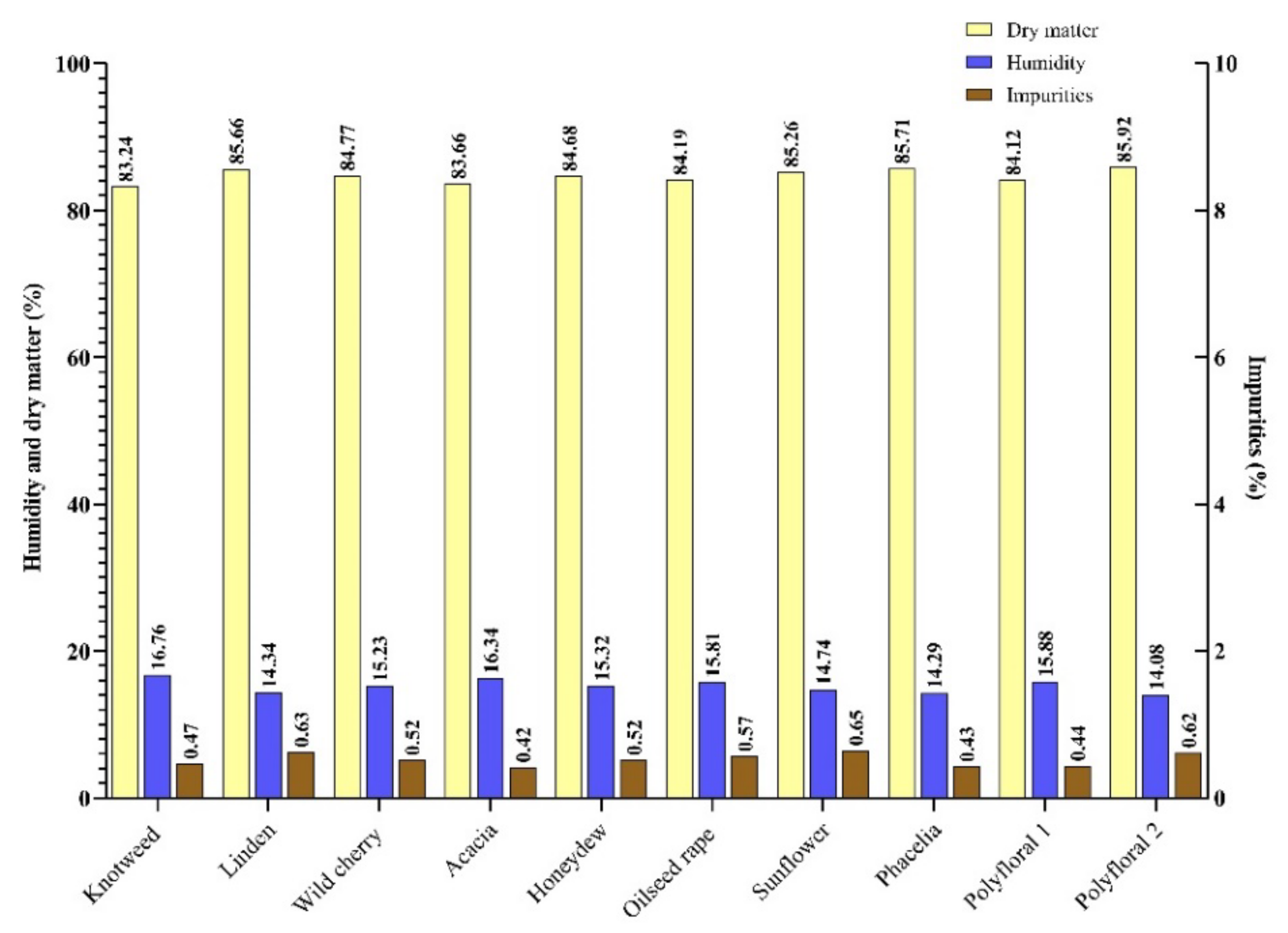
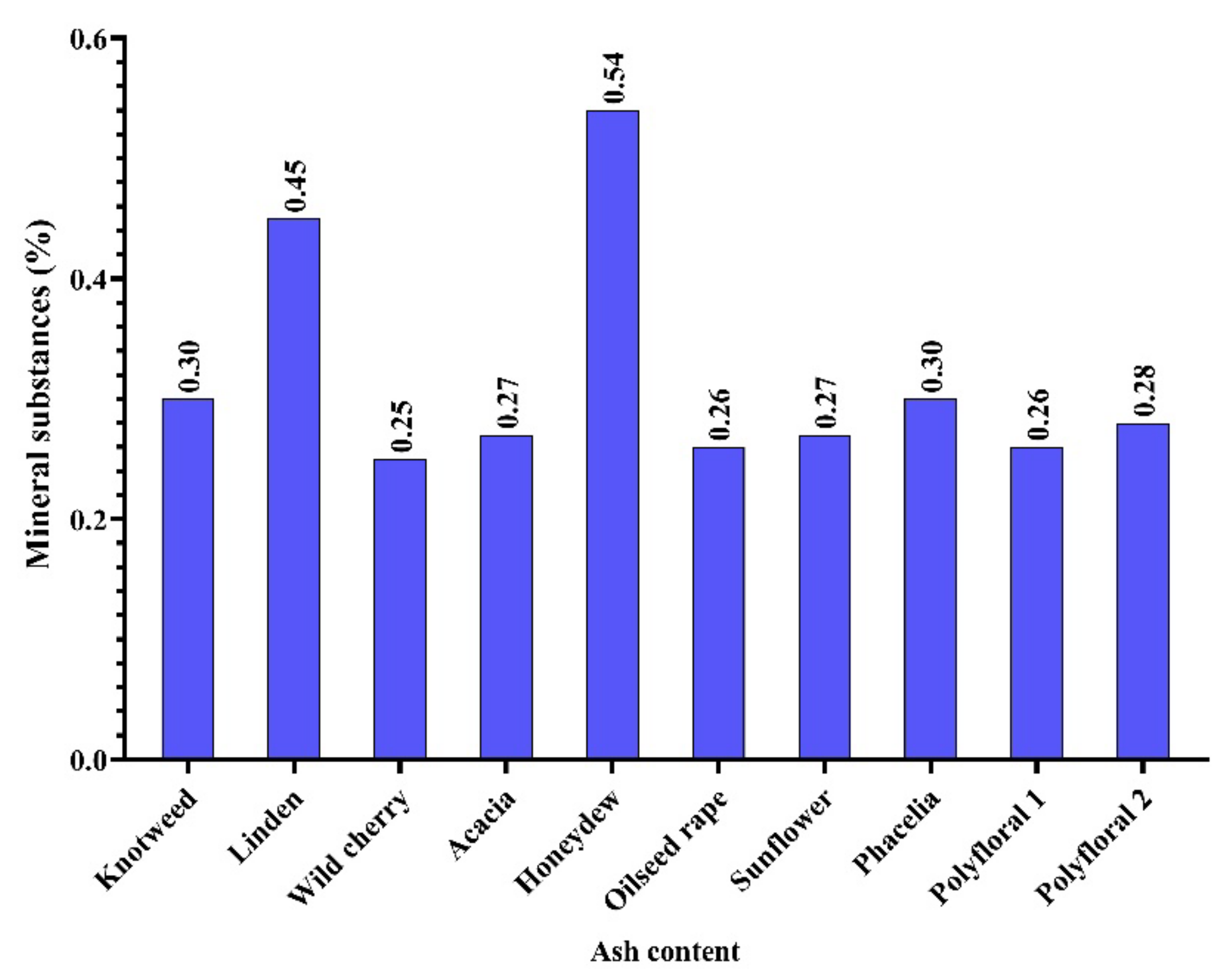
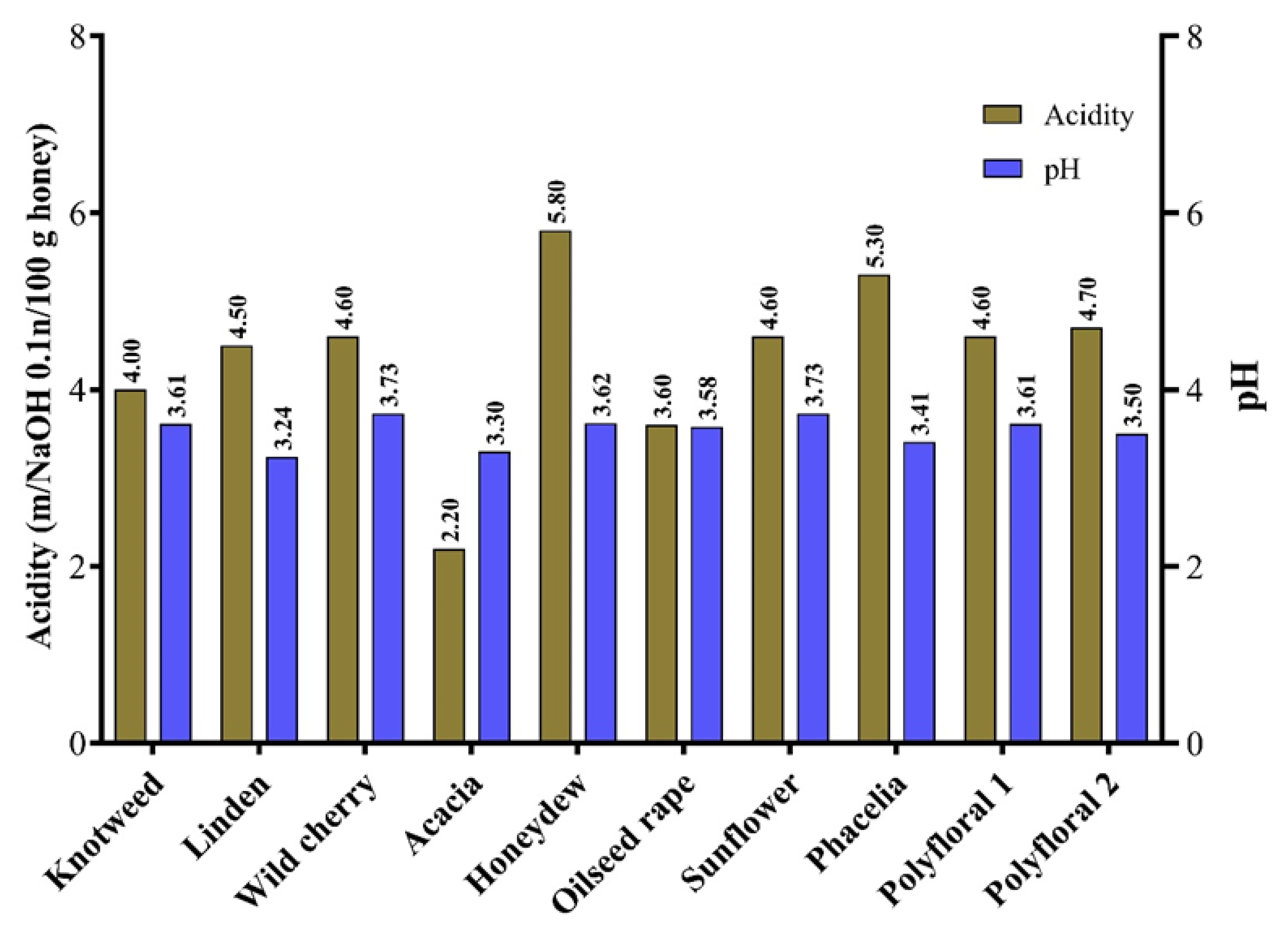
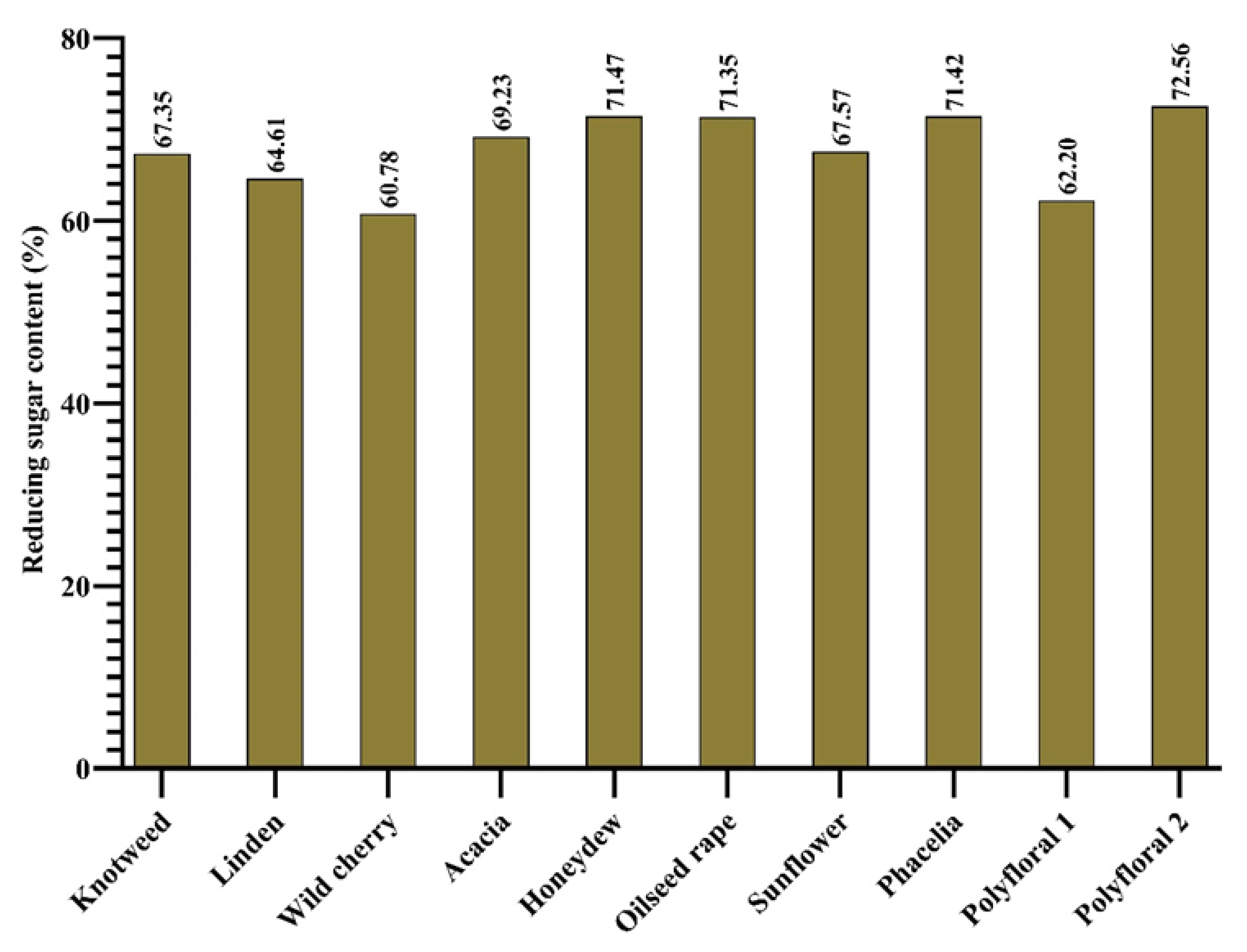
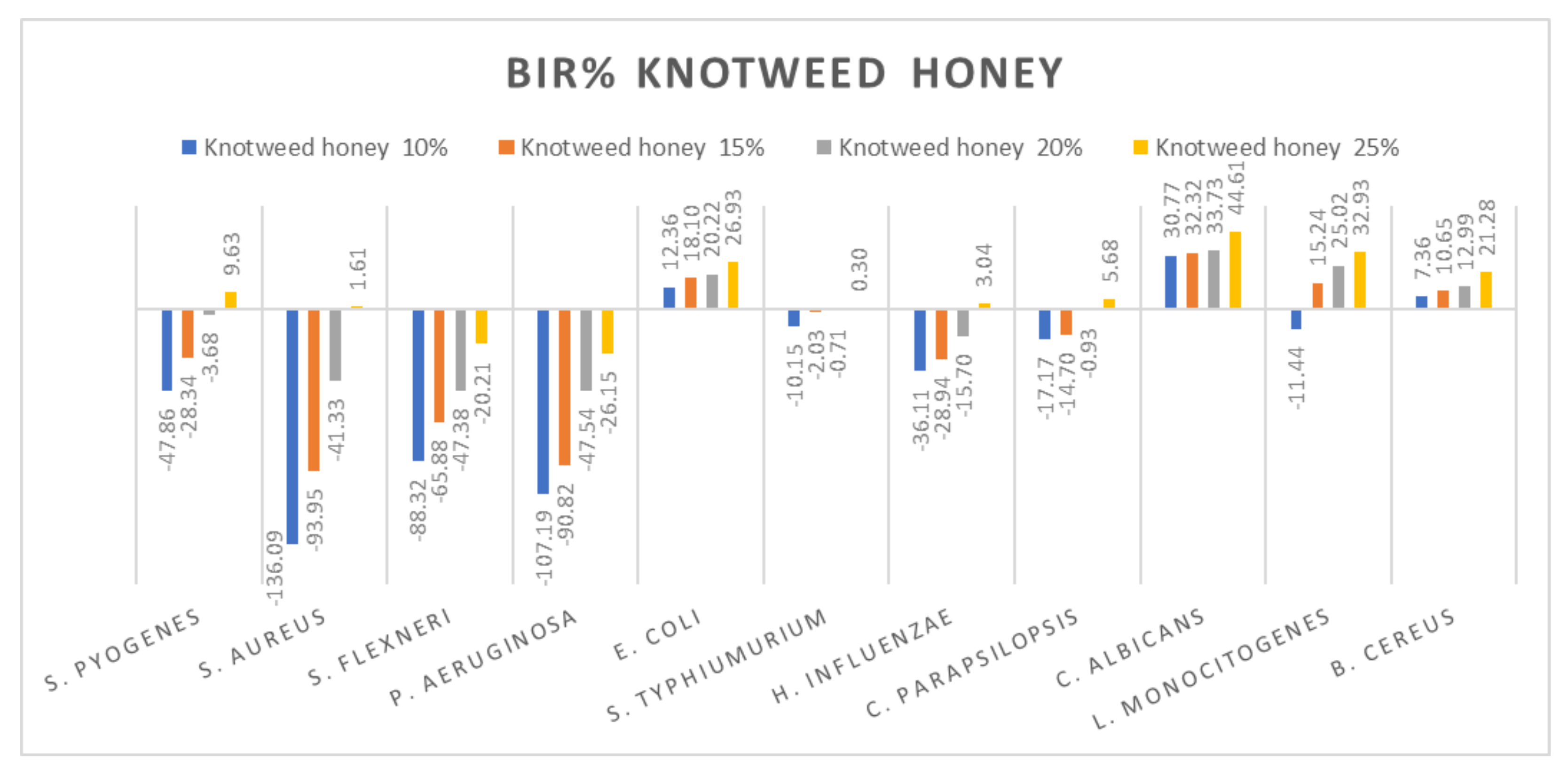
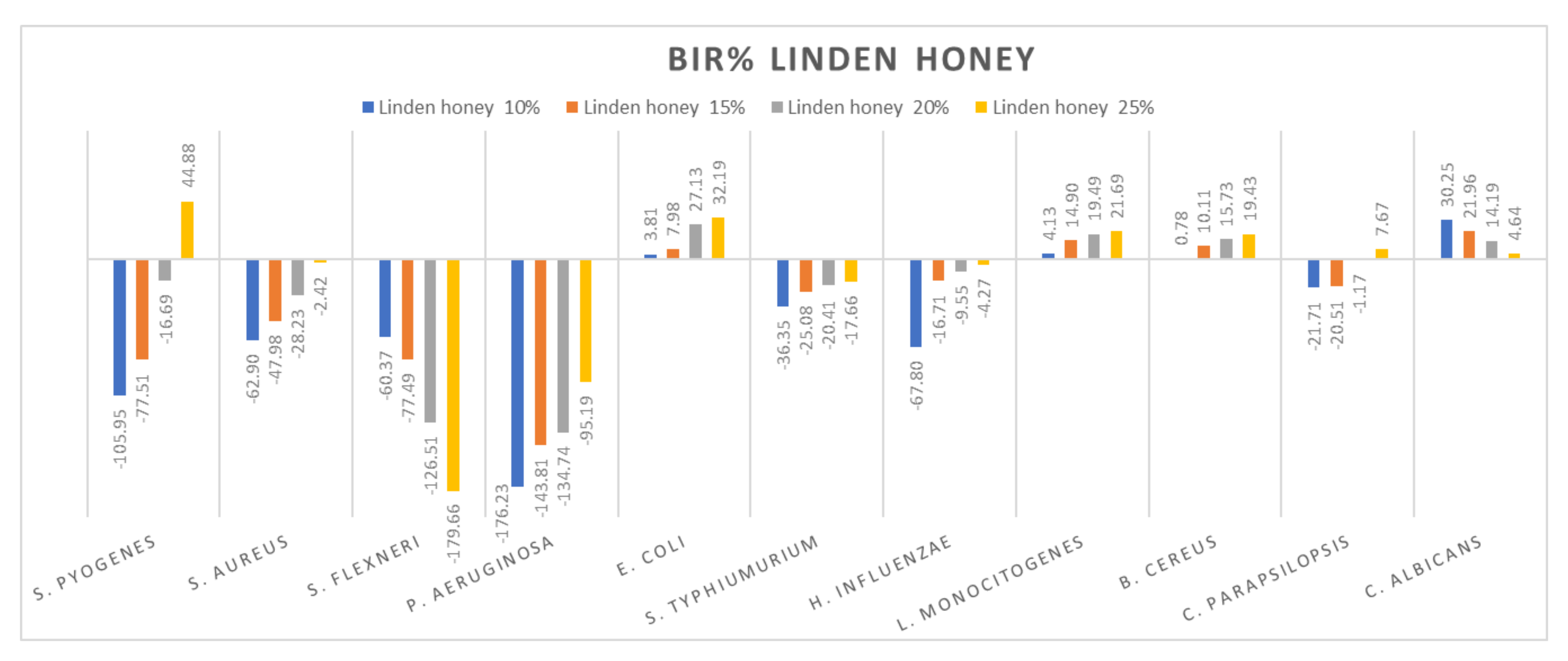
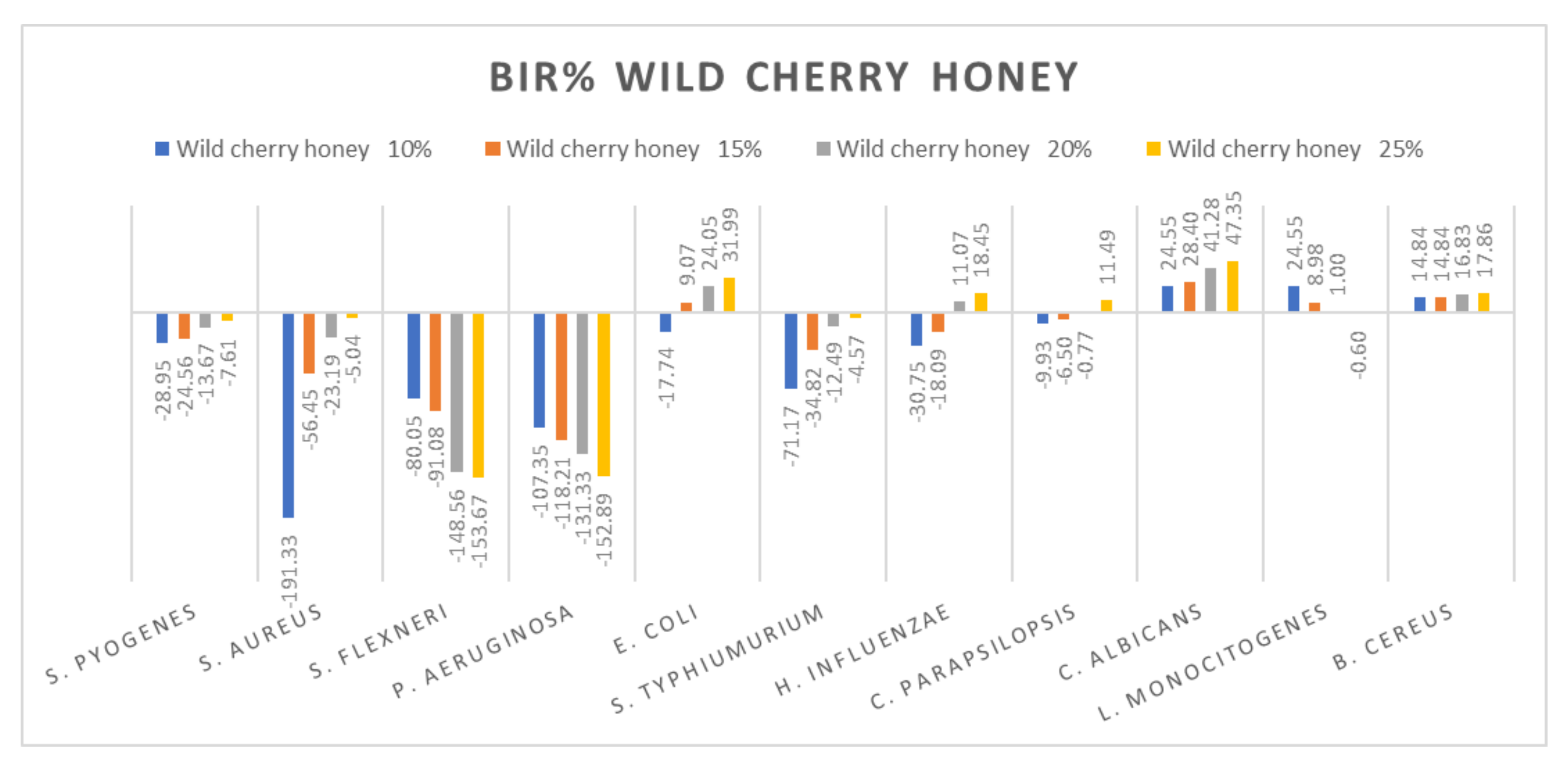
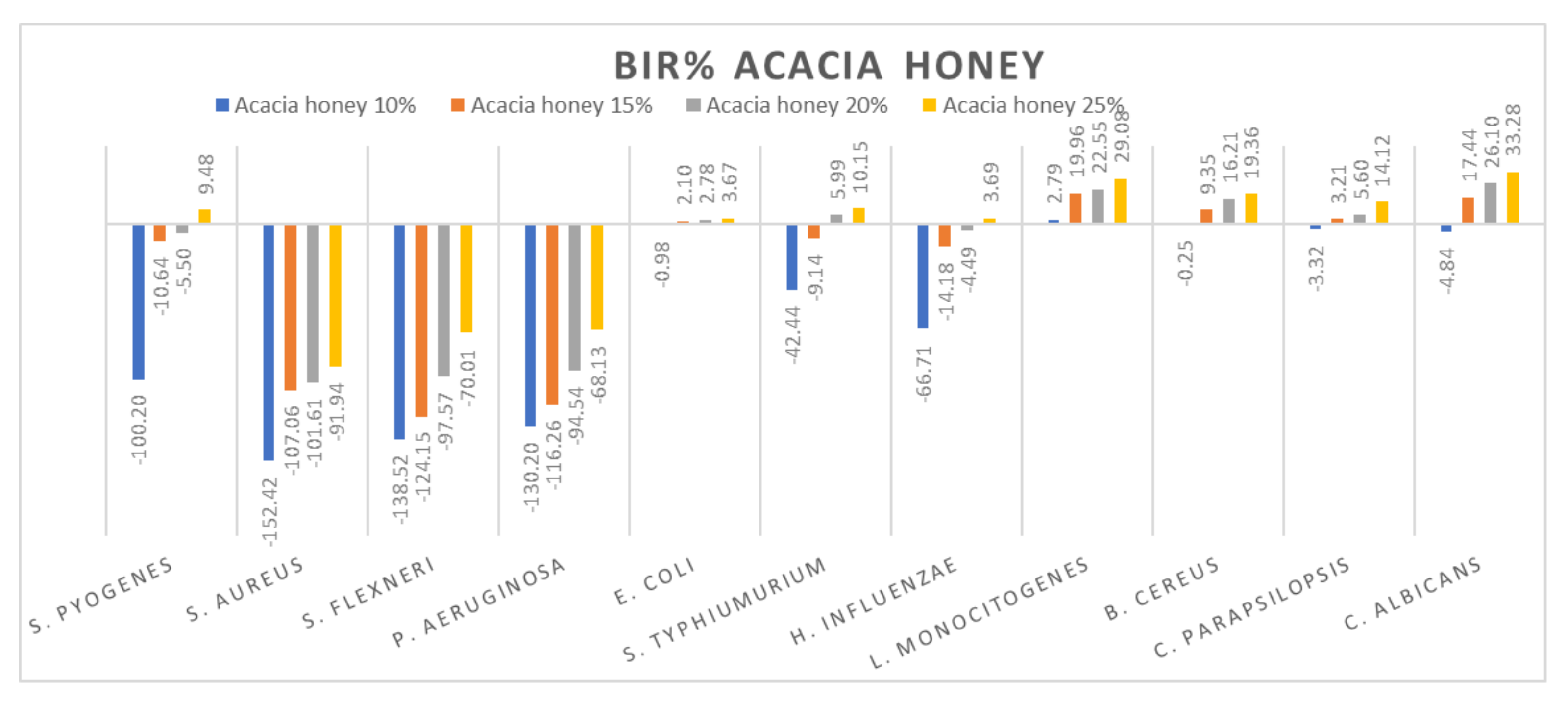
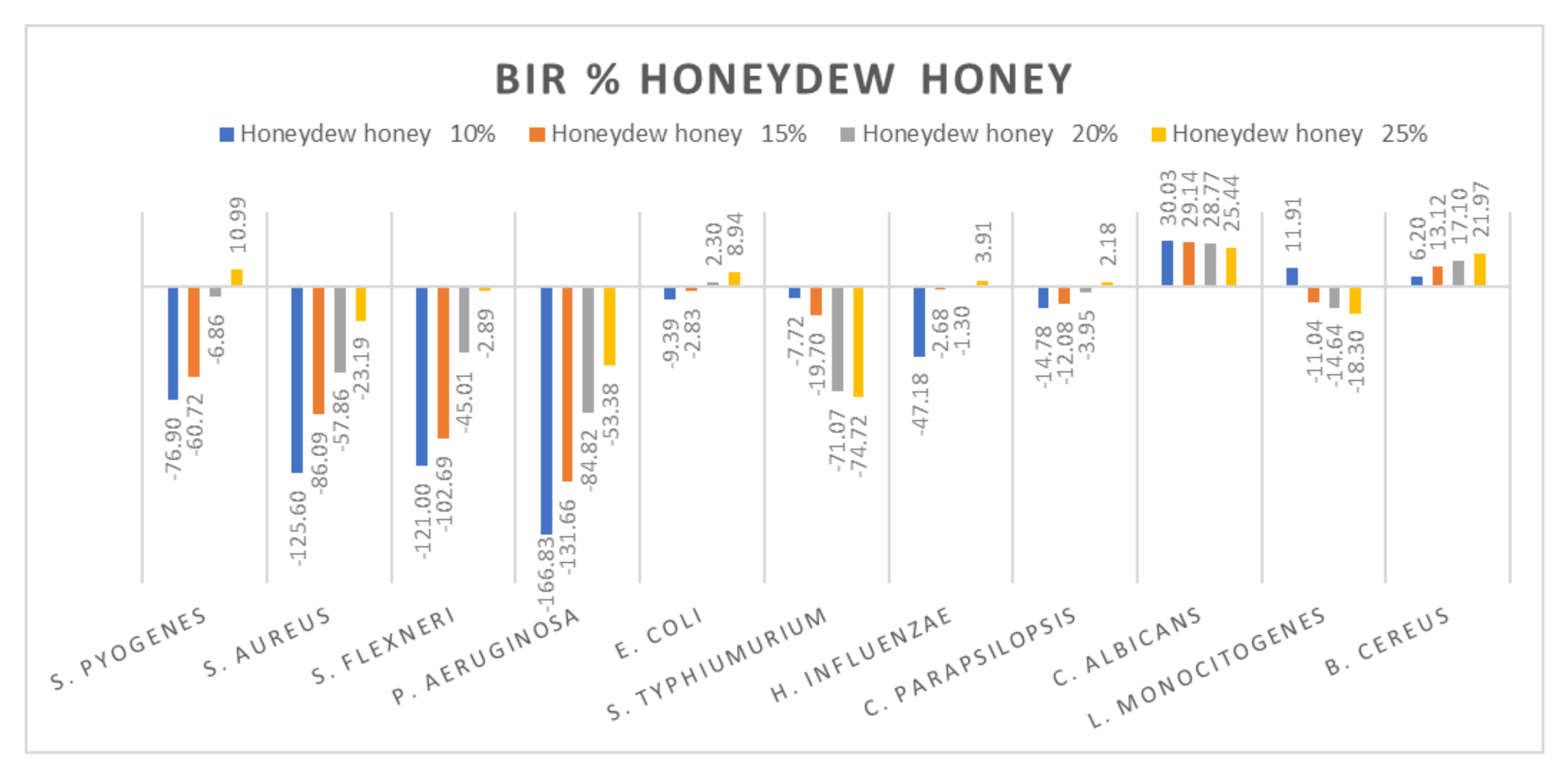
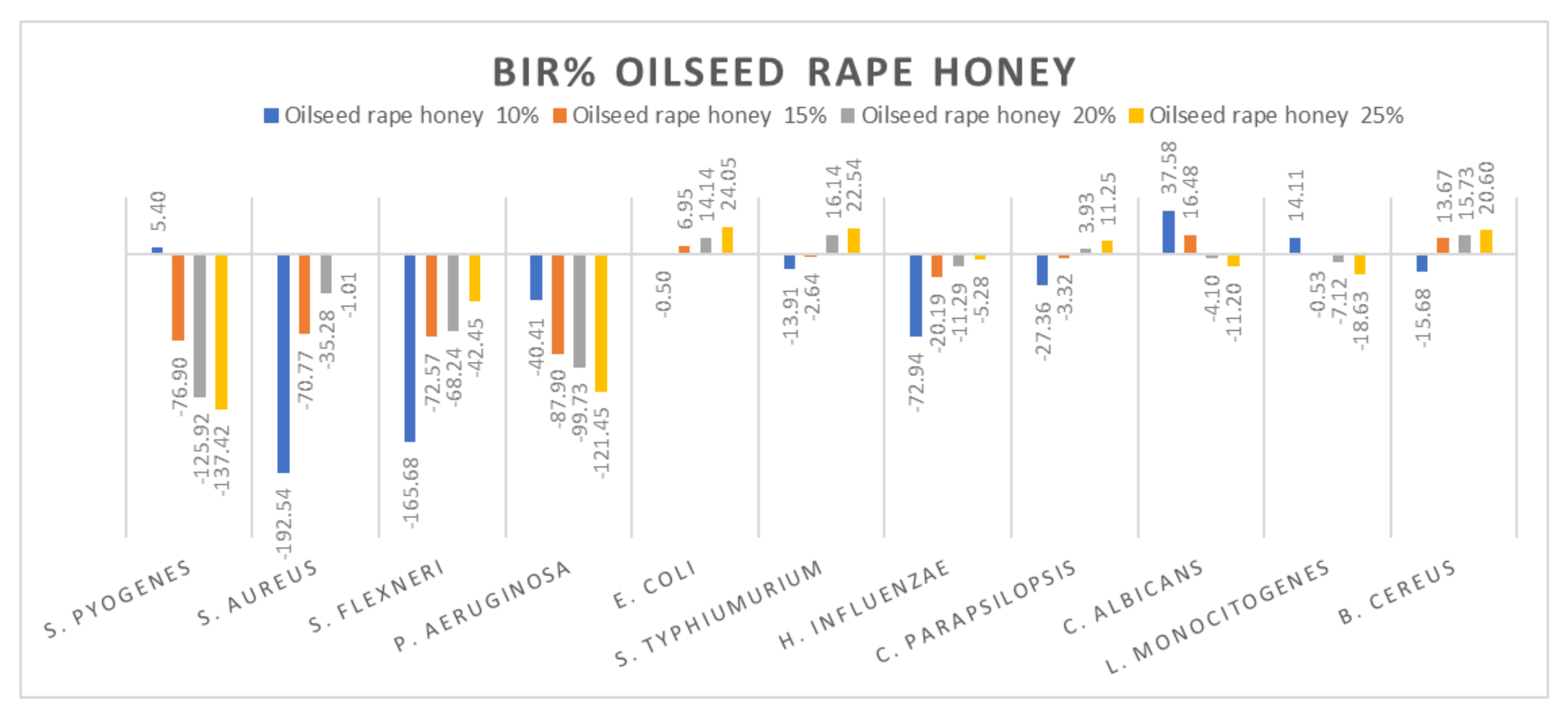
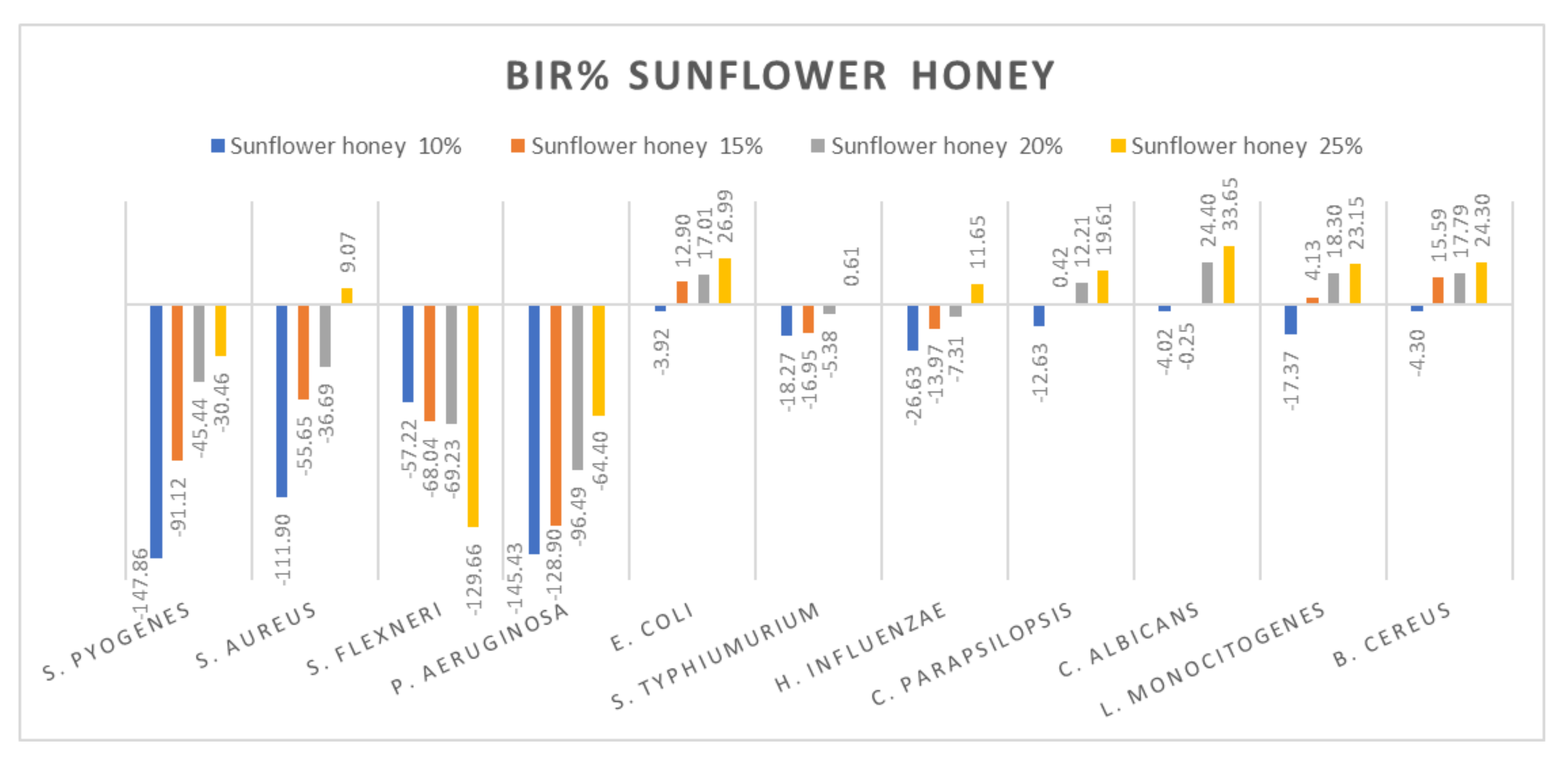
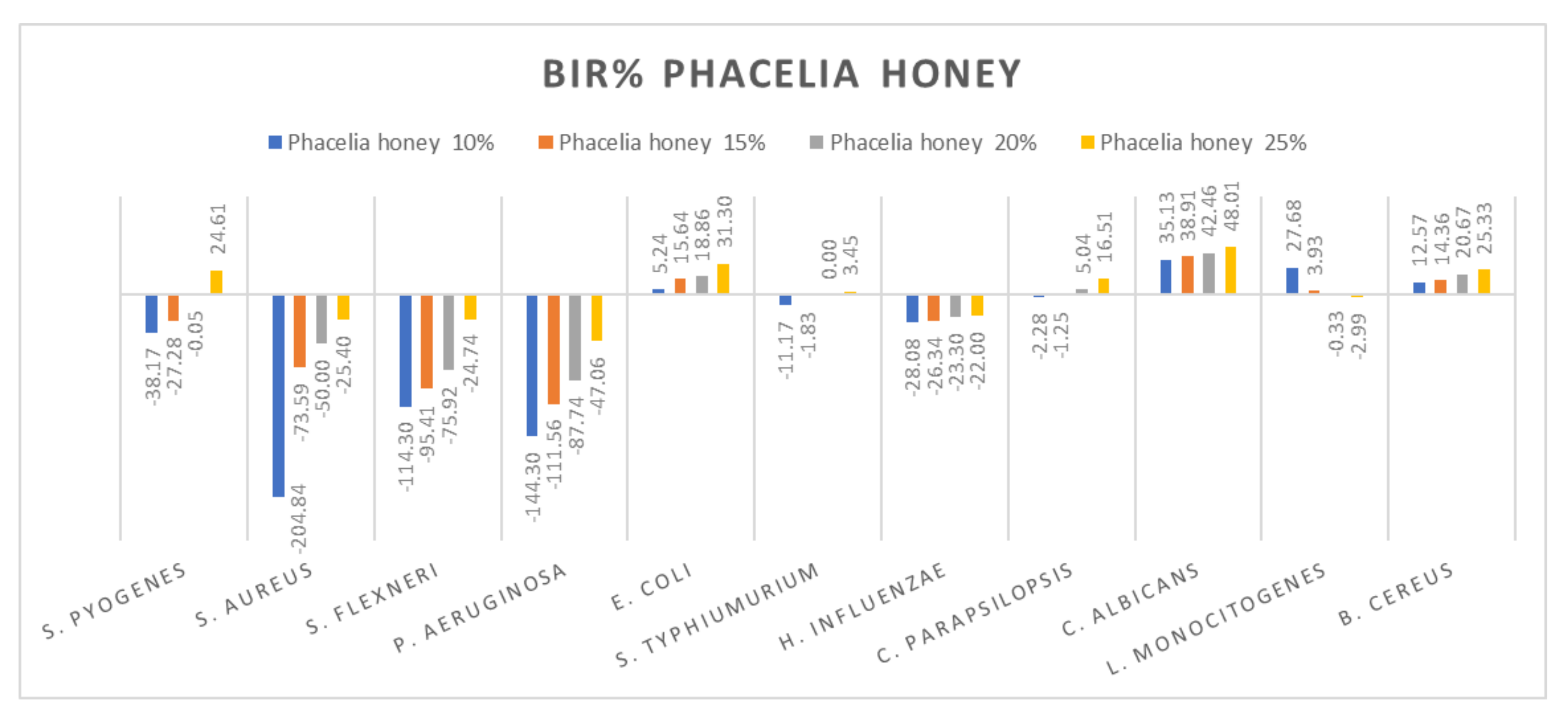

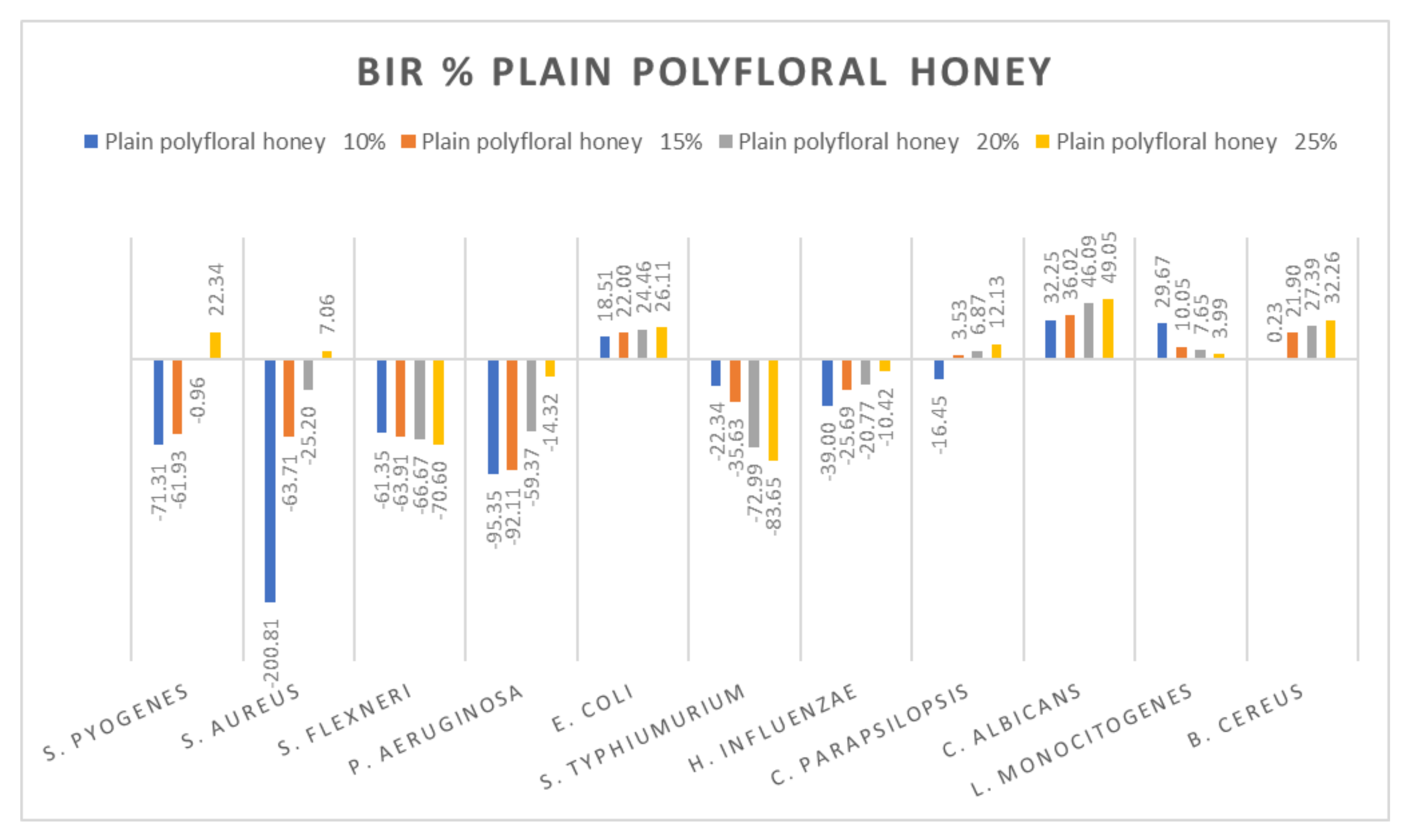
| Type of Honey | K | Ca | Mg | Na | Fe | Zn | Mn | Cu | Ni | Pb | Cr | Cd |
|---|---|---|---|---|---|---|---|---|---|---|---|---|
| Knotweed | 81.332 j ±0.002 | 32.521 j ±0.0002 | 35.280 j ±0.0001 | 7.673 j ±0.0001 | 4.261 a ±0.0002 | 3.133 i ±0.0058 | 0.954 h ±0.003 | 4.272 j ±0.001 | 0.220 j ±0.001 | 0.163 g ±0.010 | 0.114 a ±0.001 | 0.130 j ±0.001 |
| Linden | 85.706 b ±0.002 | 70.547 b ±0.0002 | 40.700 b ±0.0001 | 12.510 b ±0.000 | 8.457 b ±0.0002 | 3.881 b ±0.0001 | 1.345 b ±0.003 | 5.139 b ±0.001 | 0.233 b ±0.001 | 0.076 b ±0.010 | 0.116 b ±0.001 | 0.049 b ±0.001 |
| Wild cherry | 74.364 f ±0.002 | 39.549 f ±0.0002 | 33.883 f ±0.0001 | 6.512 f ±0.0001 | 5.938 c ±0.0002 | 3.255 f ±0.0001 | 1.125 f ±0.003 | 3.902 f ±0.001 | 0.155 f ±0.001 | 0.111 a ±0.010 | 0.105 f ±0.001 | 0.089 f ±0.001 |
| Acacia | 56.749 a ±0.002 | 37.370 a ±0.0002 | 35.179 a ±0.0001 | 13.025 a ±0.0001 | 7.284 d ±0.0002 | 4.550 a ±0.0001 | 0.902 a ±0.003 | 6.986 a ±0.001 | 0.249 a ±0.001 | 0.109 a ±0.010 | 0.114 a ±0.001 | 0.078 a ±0.001 |
| Honeydew | 82.367 e ±0.002 | 67.473 e ±0.0002 | 39.846 e ±0.0001 | 7.591 e ±0.0001 | 6.237 e ±0.0002 | 2.780 e ±0.0001 | 4.999 e ±0.003 | 4.505 e ±0.001 | 0.199 e ±0.001 | 0.118 d ±0.010 | 0.110 e ±0.001 | 0.099 e ±0.001 |
| Oilseed rape | 78.076 d ±0.002 | 41.440 d ±0.0002 | 35.387 d ±0.0001 | 4.671 d ±0.0001 | 3.934 f ±0.0002 | 3.121 d ±0.0001 | 0.720 d ±0.003 | 4.000 d ±0.001 | 0.209 d ±0.001 | 0.118 d ±0.010 | 0.108 d ±0.001 | 0.028 d ±0.001 |
| Sunflower | 65.089 c ±0.002 | 54.280 c ±0.0002 | 38.097 c ±0.0001 | 8.203 c ±0.0001 | 7.218 g ±0.0002 | 3.177 c ±0.0001 | 0.551 c ±0.003 | 5.037 c ±0.001 | 0.202 c ±0.000 | 0.131 c ±0.010 | 0.108 c ±0.001 | 0.061 c ±0.001 |
| Phacelia | 73.078 i ±0.002 | 42.825 i ±0.0002 | 38.865 i ±0.0001 | 6.535 i ±0.0001 | 4.903 h ±0.0002 | 3.074 h ±0.0001 | 0.552 c ±0.003 | 3.994 i ±0.001 | 0.163 i ±0.001 | 0.147 e ±0.010 | 0.118 i ±0.001 | 0.024 i ±0.001 |
| Polyfloral 1 | 76.917 g ±0.002 | 40.490 g ±0.0002 | 34.961 g ±0.0001 | 5.865 g ±0.0001 | 4.592 i ±0.0002 | 4.356 g ±0.0001 | 0.769 g ±0.003 | 5.056 g ±0.001 | 0.171 g ±0.001 | 0.149 e ±0.010 | 0.106 g ±0.001 | 0.068 g ±0.001 |
| Polyfloral 2 | 64.977 h ±0.002 | 44.503 h ±0.0002 | 36.409 h ±0.0001 | 6.206 h ±0.0001 | 4.085 j ±0.0002 | 2.783 e ±0.0001 | 0.551 c ±0.003 | 3.947 h ±0.001 | 0.129 h ±0.001 | 0.097 f ±0.010 | 0.107 h ±0.001 | 0.108 h ±0.001 |
| P (Anova test) | 0.000 | 0.000 | 0.000 | 0.000 | 0.000 | 0.000 | 0.000 | 0.000 | 0.000 | 0.000 | 0.000 | 0.000 |
| Type of Honey | Polyphenols | Flavonoids | Antioxidant Capacity (DPPH) |
|---|---|---|---|
| Knotweed | 187.00 ± 0.200 a | 24.32 ± 0.814 a, f | 57.22 ± 0.005 a |
| Linden | 781.10 ± 0.200 b | 263.86 ± 0.814 b, c | 79.89 ± 1.853 b |
| Wildcherry | 647.50 ± 0.200 c | 9.29 ± 0.030 d | 50.40 ± 0.005 c |
| Acacia | 177.60 ± 0.200 d | 92.42 ± 0.010 e | 41.88 ± 0.025 d |
| Honeydew | 1159.30 ± 0.300 e | 29.02 ± 0.020 a, f | 79.20 ± 0.066 b |
| Oilseed rape | 496.80 ± 0.100 f | 29.95 ± 0.808 a, f | 59.80 ± 0.110 e, f |
| Sunflower | 854.10 ± 0.400 g | 269.43 ± 0.760 a, c | 77.07 ± 0.037 g |
| Phacelia | 910.00 ± 0.300 h | 26.20 ± 0.030 f | 66.71 ± 0.390 h |
| Hill polyfloral honey | 350.80 ± 0.300 i | 29.48 ± 0.808 f | 58.56 ± 0.020 a, f |
| Plain polyfloral honey | 565.90 ± 0.200 j | 29.01 ± 6.455 f | 57.25 ± 0.040 a |
| Mean | 613.01 | 80.30 | 62.80 |
| SD | 321.41 | 100.60 | 12.74 |
| Min | 177.60 | 9.29 | 41.88 |
| Max | 1159.30 | 269.43 | 79.89 |
| P (Anova test) * | 0.000 | 0.000 | 0.000 |
| No. Sample | Botanical Origin | Geographical Origin |
|---|---|---|
| 1 | Knotweed (Fallopia japonica) | Caransebeș |
| 2 | Linden (Tilia europea) | Timișoara |
| 3 | Wild cherry (Prunus avium subsp. Avium) | Radimna |
| 4 | Acacia (Robinia pseudoacacia) | Caransebeș |
| 5 | Honeydew | Reșița |
| 6 | Oilseed rape (Brasica napus) | Sânandrei |
| 7 | Sunflower (Helianthus annuus) | Sânandrei |
| 8 | Phacelia (Phacelia) | Sânandrei |
| 9 | Plain polyfloral | Sânandrei |
| 10 | Hill polyfloral | Caransebeș |
| Symbol | Line ʎ (nm) | Lanpenstrom (mA) | Spalt (nm) |
|---|---|---|---|
| Cu | 324.8 | 4 | 0.5 |
| Ca | 422.7 | 10 | 0.5 |
| Ni | 232.0 | 4 | 0.2 |
| Fe | 248.3 | 5 | 0.2 |
| Pb | 217.0 | 10 | 1.0 |
| Na | 589.0 | 3 | 0.8 |
| Cr | 357.9 | 8 | 0.2 |
| Zn | 213.9 | 5 | 1.0 |
| K | 766.5 | 4 | 0.8 |
| Mn | 279.5 | 5 | 0.2 |
| Cd | 228.8 | 4 | 0.5 |
| Mg | 285.2 | 4 | 0.5 |
Publisher’s Note: MDPI stays neutral with regard to jurisdictional claims in published maps and institutional affiliations. |
© 2022 by the authors. Licensee MDPI, Basel, Switzerland. This article is an open access article distributed under the terms and conditions of the Creative Commons Attribution (CC BY) license (https://creativecommons.org/licenses/by/4.0/).
Share and Cite
Pătruică, S.; Alexa, E.; Obiștioiu, D.; Cocan, I.; Radulov, I.; Berbecea, A.; Lazăr, R.N.; Simiz, E.; Vicar, N.M.; Hulea, A.; et al. Chemical Composition, Antioxidant and Antimicrobial Activity of Some Types of Honey from Banat Region, Romania. Molecules 2022, 27, 4179. https://doi.org/10.3390/molecules27134179
Pătruică S, Alexa E, Obiștioiu D, Cocan I, Radulov I, Berbecea A, Lazăr RN, Simiz E, Vicar NM, Hulea A, et al. Chemical Composition, Antioxidant and Antimicrobial Activity of Some Types of Honey from Banat Region, Romania. Molecules. 2022; 27(13):4179. https://doi.org/10.3390/molecules27134179
Chicago/Turabian StylePătruică, Silvia, Ersilia Alexa, Diana Obiștioiu, Ileana Cocan, Isidora Radulov, Adina Berbecea, Roxana Nicoleta Lazăr, Eliza Simiz, Nicoleta Maria Vicar, Anca Hulea, and et al. 2022. "Chemical Composition, Antioxidant and Antimicrobial Activity of Some Types of Honey from Banat Region, Romania" Molecules 27, no. 13: 4179. https://doi.org/10.3390/molecules27134179






